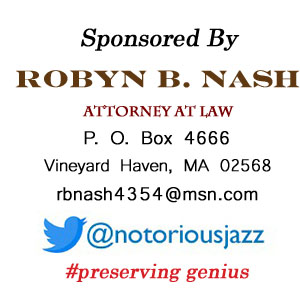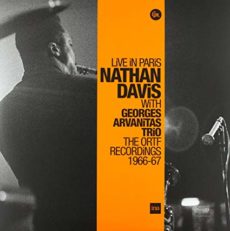
Daily Dose Of Jazz…
Nathan Tate Davis was born on February 15, 1937 in Kansas City, Kansas and eventually would travel extensively around Europe after World War II. He moved to Paris in 1962 but would return to the U.S. by 1969, holding a Ph.D. in Ethnomusicology from Wesleyan University and was a professor of music and director of jazz studies at the University of Pittsburgh, an academic program that he helped initiate.
He was the founder and director of the University of Pittsburgh Annual Jazz Seminar and Concert, the first academic jazz event of its kind in the United States. He also helped to found the university’s William Robinson Recording Studio as well as establish the International Academy of Jazz Hall of Fame located in the school’s William Pitt Union and the University of Pittsburgh-Sonny Rollins International Jazz Archives.
One of Davis’ best known musical associations was heading the Paris Reunion Band from 1985 to1989, which at different times included Nat Adderley, Kenny Drew, Johnny Griffin, Slide Hampton, Joe Henderson, Idris Muhammad, Dizzy Reece, Woody Shaw, and Jimmy Woode. He also toured and recorded with the post-bop ensemble leading Roots which he formed in 1991. He composed various pieces, including a 2004 opera entitled Just Above My Head.
He retired as director of the Jazz Studies Program at Pitt in 2013. Davis also served as the editor of the International Jazz Archives Journal. Over the course of his career, he recorded eighteen albums as a leader.
Multi-instrumentalist Nathan Davis, who played the tenor saxophone, soprano saxophone, bass clarinet, and flute, and was awarded the Mid-Atlantic Arts Foundation’s BNY Mellon Jazz Living Legacy Award at the Kennedy Center for the Performing Arts, passed away in Palm Beach, Florida on April 8, 2018 at the age of 81.
More Posts: clarinet,educator,flute,history,instrumental,jazz,music,saxophone
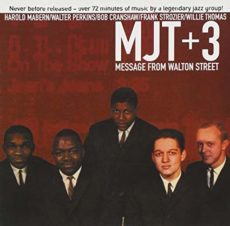
Daily Dose Of Jazz…
Walter “Baby Sweets” Perkins was born on February 10, 1932 in Chicago, Illinois. Starting out in his hometown, he began his professional career drumming with Ahmad Jamal in 1956–57. He recorded as a leader for Argo Records in 1957 under the name MJT+3 with trumpeter Paul Serrano, Nicky Hill on tenor saxophone, Muhal Richard Abrams on piano, and bassist Bob Cranshaw.
1959 witnessed the regrouping under the same name with Willie Thomas on trumpet, Frank Strozier on alto saxophone, pianist Harold Mabern, and Cranshaw on bass. They recorded four albums for Vee-Jay in 1959 and 1960 and played in Chicago until 1962 when Walter made his move to New York City.
Perkins played with Sonny Rollins in 1962 and accompanied Carmen McRae in 1962–63. By 1964 he was playing with Art Farmer and Teddy Wilson, however, following this he recorded with Rahsaan Roland Kirk, George Shearing, Gene Ammons, Charles Mingus, Billy Taylor, Etta James, J.J. Johnson, Johnny Coles, Booker Ervin, Jaki Byard, Lucky Thompson, Pat Martino, Sonny Stitt, Sonny Criss, Ray Bryant, Duke Pearson, Bobby Timmons, and Charles Earland. And that’s the shortlist as he recorded some 44 albums throughout his career as a sideman.
Drummer Walter Perkins passed away on February 14, 2004 in Queens, New York.
More Posts: bandleader,history,instrumental,jazz,music,vocal
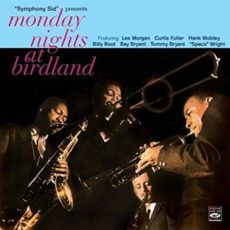
Requisites
Monday Night at Birdland is a live album that was recorded on April 21, 1958 at Birdland in New York City and released by the Roulette label.
Track Listing | 46:00
- Introduction by Symphony Sid – 0:09
- Walkin’ (Richard Carpenter) – 12:26
- All the Things You Are (Jerome Kern, Oscar Hammerstein II) – 11:27
- Bag’s Groove (Milt Jackson) – 12:29
- There Will Never Be Another You (Harry Warren, Mack Gordon) – 9:29
- Hank Mobley, Billy Root – tenor saxophone
- Lee Morgan – trumpet
- Curtis Fuller – trombone
- Ray Bryant – piano
- Tommy Bryant – bass
- Specs Wright – drums
Monday Night at Birdland | by Eddie Carter
This morning’s subject of discussion takes us to the legendary jazz club Birdland where Monday nights were always special, especially during the fifties and sixties. Musicians and vocalists who were performing would be off that night and the stage would be given to up and coming jazz artists. Thankfully, Roulette Records was available to record the performance on April 21st to give jazz fans, Monday Night at Birdland (Roulette R–52015/SR–52015) to enjoy for all who couldn’t be there in person. The Master of Ceremonies for these weekly jam sessions is the legendary jazz disc jockey, “Symphony Syd” Torin of WBNX in the Bronx, New York; WHOM in Jersey City, New Jersey, and WWRL, WMCA and WJZ in New York City. Syd announces all the tunes on the album and has a brief comment after three of them conclude. The stars of this set are Lee Morgan on trumpet; Curtis Fuller on trombone; Hank Mobley, Billy Root on tenor sax; Ray Bryant on piano; Tommy Bryant on bass and “Specs” Wright on drums. My copy used in this report is the 1988 Spanish Mono reissue (FSR-631) by Fresh Sound Records.
Symphony Syd starts the first side with the song’s introduction; the septet then launches Walkin’ by Richard Carpenter. The trio opens the song evolving into the ensemble’s collective melody. Hank takes the spotlight first wailing enthusiastically followed by Lee who picks up the pace with a bright tone and feisty phrasing. Curtis takes the reins next with a considerable zest for a rousing performance, Ray solos with evident delight in the next reading. “Specs” takes the final scintillating statement in exchange with the front line for a robust finish into the closing chorus and climax. The septet eases the throttle back for the 1939 standard, All The Things You Are by Jerome Kern and Oscar Hammerstein II. Fuller cooks at an easy groove on the opening melody, then infuses the lead solo with a lively simplicity and splendor. Mobley makes his presence felt on a brisk interpretation next, then Morgan illustrates his assured mastery on the trumpet with an engaging performance. Root takes his first solo next, giving an exquisite statement that fits the ensemble’s artistic temperament with a superb reading. Bryant ends with a short solo that’s profoundly moving before the collective reprise and coda.
Side Two opens with Milt Jackson’s contemporary classic, Bags’ Groove; it was written in 1952 and made its debut on Wizard of The Vibes (Blue Note LP 5011), released that year. After a collective theme treatment, Lee is up first, combining lyricism and emotion for a charming lead solo. Curtis soars joyously on the next statement, then comes Hank who takes the next reading with a solid rock-steady rhythm from beginning to end. Billy steps up next for a captivating performance unleashing red-hot notes from his horn and Ray glows brilliantly on the final spot ahead of the out-chorus and ovation. The set ends with an invigorating finale, There Will Never Be Another You by Harry Warren and Mack Gordon, originally written in 1942 and appearing in the musical film, Iceland. The propulsive power of Wright’s drums brings the song to life leading to the speedy melody. Mobley accelerates to race car speed on the opening statement and never decelerates. Root’s tenor sax is an adrenaline rush on the next scintillating solo, followed by Morgan who also gives a spectacular exhibition. Fuller pulls no punches with a buoyant, effervescent interpretation next and Bryant shows he’s a fierce and fervid performer on the closer before the closing chorus and appreciative applause from the crowd.
Monday Night at Birdland was produced by Rudy Traylor, who’s also an arranger, jazz drummer, pianist, and vibraphonist. The sound quality of the album is quite good throughout, and Hank Mobley, Billy Root, Lee Morgan, Curtis Fuller, Ray Bryant, Tommy Bryant, and “Specs” Wright offer the listener the very essence of live jazz. In fact, there’s only one noticeable defect, on Symphony Syd’s introduction of Walkin’, his microphone has a little harshness. I don’t know if this appears on the original album or is exclusive to this LP. I’ll admit, I’m not that familiar with Fresh Sound Records, and don’t know if they’re in that group of European labels like DOL, Doxy, Jazz Wax, Jazz Workshop, Wax Time, etc. However, I’m pretty impressed with what I’ve heard on this particular reissue and the performances are worth the price of admission for me to invite you to seek a copy of Monday Night at Birdland to check out for yourselves and form your own opinion!
~ All The Things You Are, There Will Never Be Another You – Source: JazzStandards.com ~ Bags’ Groove – Source: Wikipedia.org ~ © 2020 by Edward Thomas Carter
More Posts: choice,classic,collectible,collector,history,instrumental,jazz,music,saxophone
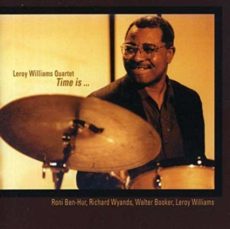
Daily Dose Of Jazz…
Leroy Williams was born in Chicago, Illinois on February 3, 1939 and first began playing drums as a teenager in the 1950s. From 1959 to the middle of the 1960s he played with Judy Roberts, and following this stint he moved to New York City and played with Booker Ervin in 1967.
1968 found him playing with Sonny Rollins, Archie Shepp, and Clifford Jordan; in 1969 he first began playing and collaboration with Barry Harris. 1970 saw him playing with Hank Mobley, Wilbur Ware, and Thelonious Monk, the latter of which he went with on a tour of Japan.
Later in the 1970s he played and recorded with Hank Mobley, Yusef Lateef, Ray Bryant, Charles McPherson, Stan Getz, Andrew Hill, Sonny Stitt, Junior Cook, Al Cohn, Buddy Tate, Ted Dunbar, Slide Hampton, Red Rodney and Bob Wilber, among others.
In the 1980s Williams played with Talk Talk, Level 42, Art Davis, Barry Harris, Tommy Flanagan, Steve Turre, and recorded with Pepper Adams, Bill Hardman. In the 1990s he performed and recorded with Frank Morgan, with Anthony Braxton, Lee Konitz, Ralph Lalama, and Pete Malinverni. Most recently, he was a member of El Mollenium with Roni Ben-Hur, Bertha Hope, and Walter Booker.
He was a member of the cast in the music documentary Bird Now and played one of the Angels of Mercy in the Steve Martin film spoof Leap Of Faith about fake faith healers. At the turn of the decade, Williams was a member of the cooperative band el Mollenium, which also included guitarist Roni Ben-hur, pianist Bertha Hope, and bassist Walter Booker. The band is devoted largely to interpreting the music of the late pianist Elmo Hope. Drummer Leroy Williams continues to be active.
More Posts: bandleader,drums,history,instrumental,jazz,music
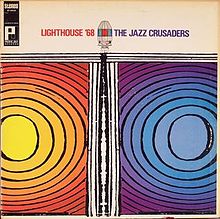
Requisites
Lighthouse ’68 is a live album by The Jazz Crusaders recorded on November 10-13, 1967 at the Lighthouse in Hermosa Beach, California and released the following year on the Pacific Jazz label. Lighthouse ’68 documents the group performing live at one of the premier West Coast clubs, The Lighthouse Café, opened in 1949.
The producer on the date was Richard Bock. The cover design was created by Gabor Halmos, the engineer was Dino Lappas, the liner notes were written by Howard Rumsey, and the liner photography was taken by Fred Seligo.
The Tracks | 44:33- Ooga-Boo-Ga-Loo (Stix Hooper) – 6:39
- Eleanor Rigby (John Lennon, Paul McCartney) – 7:32
- Native Dancer (Buster Williams) – 8:52
- Never Had It So Good (Joe Sample) – 7:15
- The Emperor (Buster Williams) – 8:50
- Impressions (John Coltrane) – 6:12
- Wayne Henderson – trombone
- Wilton Felder – tenor saxophone
- Joe Sample – piano
- Buster Williams – bass
- Stix Hooper – drums
Review by Eddie Carter
Four friends from Houston, Texas who began performing locally in 1956 were Wayne Henderson, Wilton Felder, Joe Sample, and Stix Hooper. They were originally known as The Swingsters, then The Nite Hawks, but after moving to Los Angeles, California in 1961, they changed their name and became one of the best West Coast ensembles of the sixties, The Jazz Crusaders.
The set opens with Oogo-Boo-Ga-Loo, an infectiously danceable audience grabber by Stix Hooper which begins with a lovely introduction by the trio, then blossoms into a sanctified styled theme treatment. John Lennon and Paul McCartney’s Eleanor Rigby allows their midtempo rendition to explore the melody collectively. The tempo moves up for Native Dancer, the first of two contributions by Buster Williams which gets off to a roaring start with an aggressive opening statement and nimble melodic presentation.
Sample’s Never Had It So Good starts the second side with an easy spirited beat that leads us back to church with a bit of boogaloo in the imaginative display of harmony during the group’s opening melody. The Emperor, is Williams’ second offering to the session that takes us back to straightforward bop with the solos in the same order as the previous tune.
The album ends with John Coltrane’s Impressions, takes an invigorating introduction by the trio and theme statement led by the horns followed with a jet-propelled interpretation infused with searing fire for an energetic workout and effervescent ending.
Source: Jazztracks by Eddie Carter | Excerpt: 12/2018 | atlantaaudioclub.org
More Posts: choice,classic,collectible,collector,history,instrumental,jazz,music


